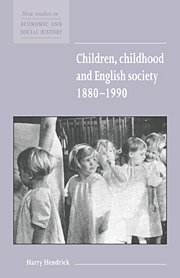Book contents
- Frontmatter
- Contents
- Acknowledgements
- 1 Introduction
- 2 New ideas of childhood: the 1880s to the 1920s
- 3 Parent–child relationships
- 4 Children and social policies
- 5 Children, schooling and the classroom
- 6 Children's leisure
- 7 Conclusion: disappearing childhood and children's rights
- Bibliography
- Index
- Titles available in the New Studies in Economic and Social History series
- Titles available in the Studies in Economic and Social History series
- Economic History Society
- Frontmatter
- Contents
- Acknowledgements
- 1 Introduction
- 2 New ideas of childhood: the 1880s to the 1920s
- 3 Parent–child relationships
- 4 Children and social policies
- 5 Children, schooling and the classroom
- 6 Children's leisure
- 7 Conclusion: disappearing childhood and children's rights
- Bibliography
- Index
- Titles available in the New Studies in Economic and Social History series
- Titles available in the Studies in Economic and Social History series
- Economic History Society
Summary
First, what is meant by ‘leisure’? The term is understood here as the time ‘which lies outside the demands of work, direct social obligations and the routine activities of personal and domestic maintenance’. The use of this time ‘is characterised by a high degree of personal freedom and choice’. Recreation, which can also be used as a specialist term, but is included here as part of leisure, is taken to mean ‘those activities and interests that form the typical occupations of leisure time’ [187: 6].
Such a definition, however, does not take us very far with reference to children's leisure for, as James Walvin has remarked, despite being a crucial feature of their lives, it has been ignored by historians and left to the antiquarian and folklorist [188: 228]. And John Springhall reminds us that it is an oversimplification to examine leisure solely by focusing on social class, since what is often of equal importance has been ‘the position of the individual in the life-cycle’ [189: 109–10]. All the same, it is ‘undeniable that whatever one's actual age, the choice of leisure activities available in the past was predominantly defined and circumscribed by social class’, by regions and by the division between urban and rural areas [189: 113; 1: 240].
- Type
- Chapter
- Information
- Children, Childhood and English Society, 1880–1990 , pp. 79 - 93Publisher: Cambridge University PressPrint publication year: 1997
- 1
- Cited by

